2016 CITROEN C-ELYSÉE Tighten
[x] Cancel search: TightenPage 109 of 260
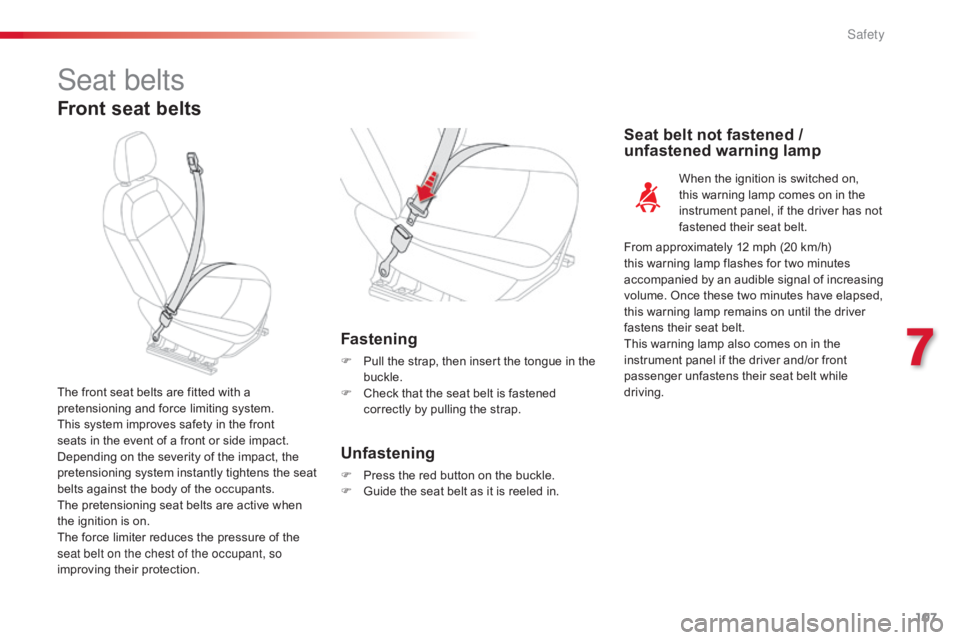
107
C-elysee_en_Chap07_securite_ed01-2016
Seat belts
Front seat belts
Fastening
F Pull the strap, then insert the tongue in the buc
kle.
F
C
heck that the seat belt is fastened
c
orrectly by pulling the strap.
Unfastening
F Press the red button on the buckle.
F G uide the seat belt as it is reeled in.
The
front
seat
belts
are
fitted
with
a
p
retensioning
and
force
limiting
system.
This
system
improves
safety
in
the
front
s
eats
in
the
event
of
a
front
or
side
impact.
D
epending
on
the
severity
of
the
impact,
the
p
retensioning
system
instantly
tightens
the
seat
b
elts
against
the
body
of
the
occupants.
The
pretensioning
seat
belts
are
active
when
t
he
ignition
is
on.
The
force
limiter
reduces
the
pressure
of
the
s
eat belt on the chest of the occupant, so
improving
their
protection. When
the ignition is switched on,
t
his warning lamp comes on in the
i
nstrument panel, if the driver has not
f
astened their seat belt.
Seat belt not fastened /
unfastened warning lamp
From approximately 12 mph (20 km/h) t
his warning lamp flashes for two minutes
a
ccompanied by an audible signal of increasing
v
olume. Once these two minutes have elapsed,
t
his warning lamp remains on until the driver
f
astens their seat belt.
This
warning lamp also comes on in the
i
nstrument panel if the driver and/or front
p
assenger unfastens their seat belt while
d
riving.
7
Safety
Page 111 of 260
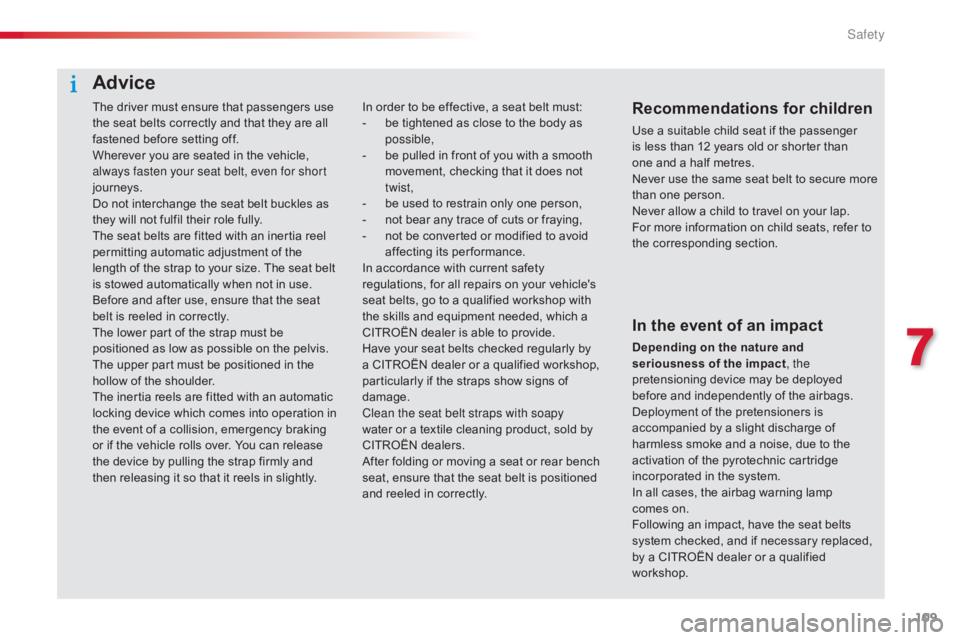
109
C-elysee_en_Chap07_securite_ed01-2016
The driver must ensure that passengers use the seat belts correctly and that they are all
f
astened before setting off.
Wherever
you are seated in the vehicle,
a
lways fasten your seat belt, even for short
journeys.
Do
not interchange the seat belt buckles as
t
hey will not fulfil their role fully.
The
seat belts are fitted with an inertia reel
p
ermitting automatic adjustment of the
l
ength of the strap to your size. The seat belt
i
s stowed automatically when not in use.
Before
and after use, ensure that the seat
b
elt is reeled in correctly.
The
lower part of the strap must be
p
ositioned as low as possible on the pelvis.
The
upper part must be positioned in the
h
ollow of the shoulder.
The
inertia reels are fitted with an automatic
l
ocking device which comes into operation in
t
he event of a collision, emergency braking
o
r if the vehicle rolls over. You can release
t
he device by pulling the strap firmly and
t
hen releasing it so that it reels in slightly.Recommendations for children
Use a suitable child seat if the passenger is less than 12 years old or shorter than
o
ne and a half metres.
Never
use the same seat belt to secure more
t
han one person.
Never
allow a child to travel on your lap.
For
more information on child seats, refer to
t
he corresponding section.
In
order
to
be
effective,
a
seat
belt
must:
-
b
e
tightened
as
close
to
the
body
as
p
ossible,
-
b
e
pulled
in
front
of
you
with
a
smooth
m
ovement,
checking
that
it
does
not
t
wist,
-
b
e
used
to
restrain
only
one
person,
-
n
ot
bear
any
trace
of
cuts
or
fraying,
-
n
ot
be
converted
or
modified
to
avoid
a
ffecting
it
s
p
erformance.
In
accordance
with
current
safety
r
egulations,
for
all
repairs
on
your
vehicle's
s
eat
belts,
go
to
a
qualified
workshop
with
t
he
skills
and
equipment
needed,
which
a
C
ITROËN
dealer
is
able
to
provide.
Have
your
seat
belts
checked
regularly
by
a
CITROËN
dealer
or
a
qualified
workshop,
p
articularly
if
the
straps
show
signs
of
d
amage.
Clean the seat belt straps with soapy
water
or
a
textile
cleaning
product,
sold
by
C
ITROËN
dealers.
After
folding
or
moving
a
seat
or
rear
bench
s
eat,
ensure
that
the
seat
belt
is
positioned
a
nd
reeled
in
correctly.
In the event of an impact
Depending on the nature and
seriousness of the impact , the
pretensioning
device may be deployed
b
efore and independently of the airbags.
D
eployment of the pretensioners is
a
ccompanied by a slight discharge of
h
armless smoke and a noise, due to the
a
ctivation of the pyrotechnic cartridge
i
ncorporated in the system.
In
all cases, the airbag warning lamp
c
omes on.
Following
an impact, have the seat belts
s
ystem checked, and if necessary replaced,
b
y a CITROËN dealer or a qualified
w
orkshop.
Advice
7
Safety
Page 124 of 260

122
C-elysee_en_Chap08_securite-enfants_ed01-2016
The incorrect installation of a child seat in a vehicle compromises the child's protection in
t
he event of an accident.
Ensure
that there is no seat belt or seat belt
b
uckle under the child seat, as this could
de
stabilise
i
t.
Remember
to fasten the seat belts or the
c
hild seat harnesses keeping the slack
r
elative to the child's body to a minimum,
e
ven for short journeys.
When
installing a child seat using the seat
b
elt, ensure that the seat belt is tightened
c
orrectly on the child seat and that it secures
t
he child seat firmly on the seat of your
v
ehicle. If your passenger seat is adjustable,
m
ove it for wards if necessary.
At
rear seating positions, always leave
s
ufficient space between the front seat and:
-
a
rear ward facing child seat,
-
t
he child's feet for a child seat fitted
fo
rward
f
acing.
To
do this, move the front seat for wards
a
nd, if necessary, move its backrest into the
u
pright
p
osition.
Advice
As a safety precaution, do not leave:
- a child or children alone and
u
nsupervised in a vehicle,
-
a
child or an animal in a vehicle which
i
s exposed to the sun, with the windows
c
losed,
-
t
he keys within reach of children inside
t
he vehicle.
To
prevent accidental opening of the doors
a
nd rear windows, use the child lock.
Take
care not to open the rear windows by
m
ore than one third.
To
protect young children from the rays of
t
he sun, fit side blinds on the rear windows.
For
o
ptimum
in
stallation
o
f
t
he
fo
rward
f
acing
c
hild
seat,
ensure
that
the
back
of
the
child
s
eat
is
as
close
as
possible
to
the
backrest
o
f
the
vehicle's
seat
,
in
contact
if
possible.
You
must
remove
the
head
restraint
before
i
nstalling
a
child
seat
with
backrest
to
a
p
assenger
sea
t.
Ensure
that
the
head
restraint
is
stored
or
a
ttached
securely
to
prevent
it
from
being
t
hrown
around
the
vehicle
in
the
event
of
s
harp
braking.
Refit
the
head
restraint
when
t
he
child
seat
is
removed.
Children at the front
The legislation on carrying children on the f
ront passenger seat is specific to each
c
ountry. Refer to the legislation in force in
y
our country.
Deactivate
the passenger's front airbag
w
hen a rear ward facing child seat is installed
o
n the front passenger seat.
Otherwise,
t
he
c
hild
r
isks
b
eing
ser
iously
i
njured or killed if the airbag is deployed.
Installing a booster seat
The chest part of the seat belt must be positioned on the child's shoulder without
t
ouching the neck.
Ensure
that the lap part of the seat belt
p
asses correctly over the child's thighs.
CITROËN
recommends the use of a booster
s
eat which has a back, fitted with a seat belt
g
uide at shoulder level.
C
Page 143 of 260
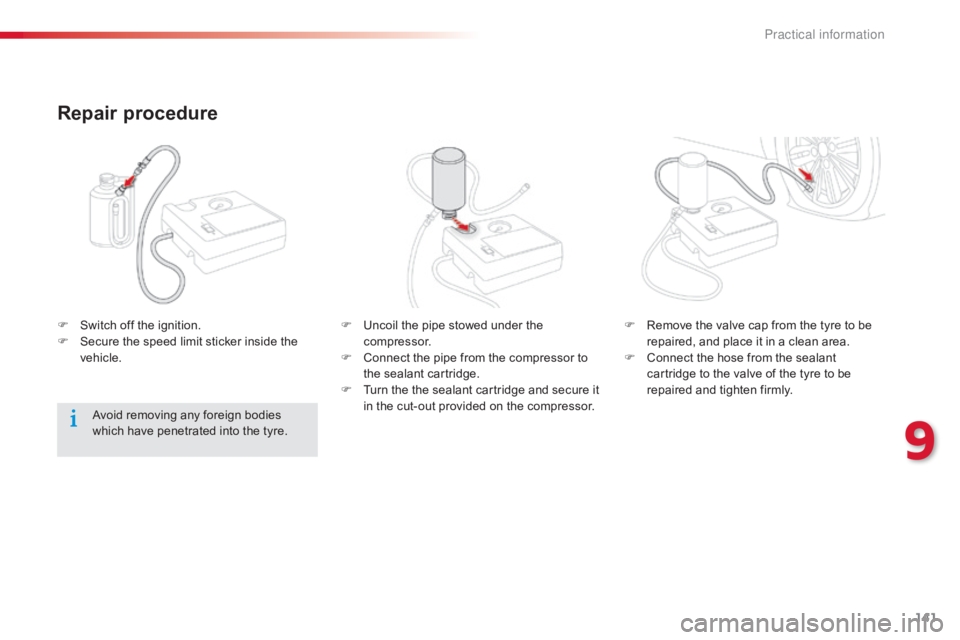
141
C-elysee_en_Chap09_info-pratiques_ed01-2016
Repair procedure
F Switch off the ignition.
F S ecure the speed limit sticker inside the
v
ehicle. F
U ncoil the pipe stowed under the c
ompressor.
F
C
onnect the pipe from the compressor to
t
he sealant cartridge.
F
T
urn the the sealant cartridge and secure it
i
n the cut-out provided on the compressor.
Avoid
removing any foreign bodies
w
hich have penetrated into the tyre. F
R emove the valve cap from the tyre to be r
epaired, and place it in a clean area.
F
C
onnect the hose from the sealant
c
artridge to the valve of the tyre to be
r
epaired and tighten firmly.
9
Pr
Page 145 of 260
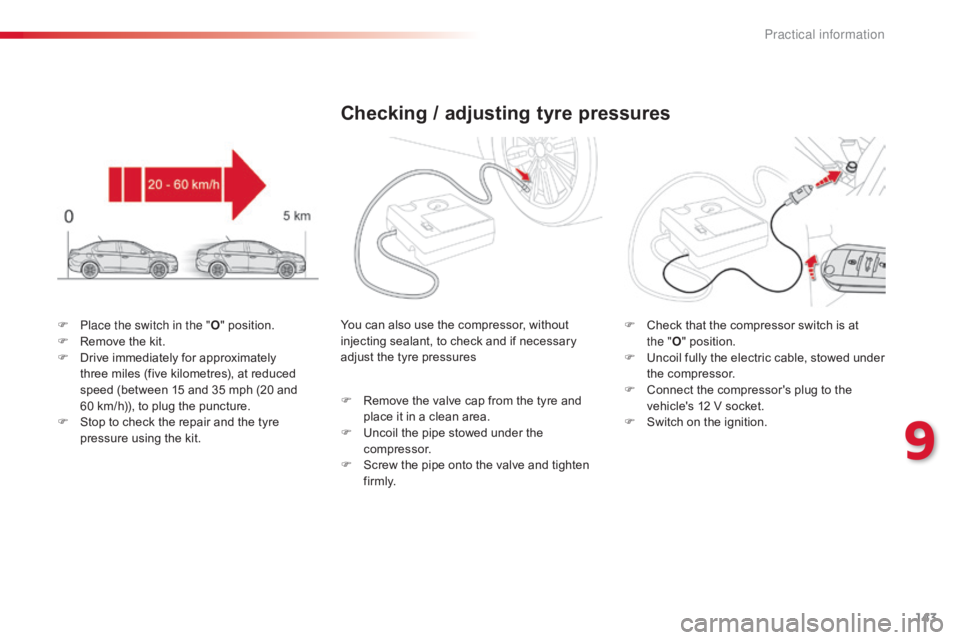
143
C-elysee_en_Chap09_info-pratiques_ed01-2016
You can also use the compressor, without injecting sealant, to check and if necessary
a
djust the tyre pressures F
C heck that the compressor switch is at
t
he "O "
position.
F
U
ncoil fully the electric cable, stowed under
t
he compressor.
F
C
onnect the compressor's plug to the
v
ehicle's 12 V socket.
F
S
witch on the ignition.
F
P
lace the switch in the " O"
position.
F
R
emove
the
kit.
F
D
rive
immediately
for
approximately
t
hree
miles
(five
kilometres),
at
reduced
s
peed
(between
15
and
35
mph
(20
and
6
0 km/h)),
to
plug
the
puncture.
F
S
top
to
check
the
repair
and
the
tyre
p
ressure
using
the
kit.
Checking / adjusting tyre pressures
F Remove the valve cap from the tyre and p
lace it in a clean area.
F
U
ncoil the pipe stowed under the
c
ompressor.
F
S
crew the pipe onto the valve and tighten
f
i r m l y.
9
Practical information
Page 152 of 260
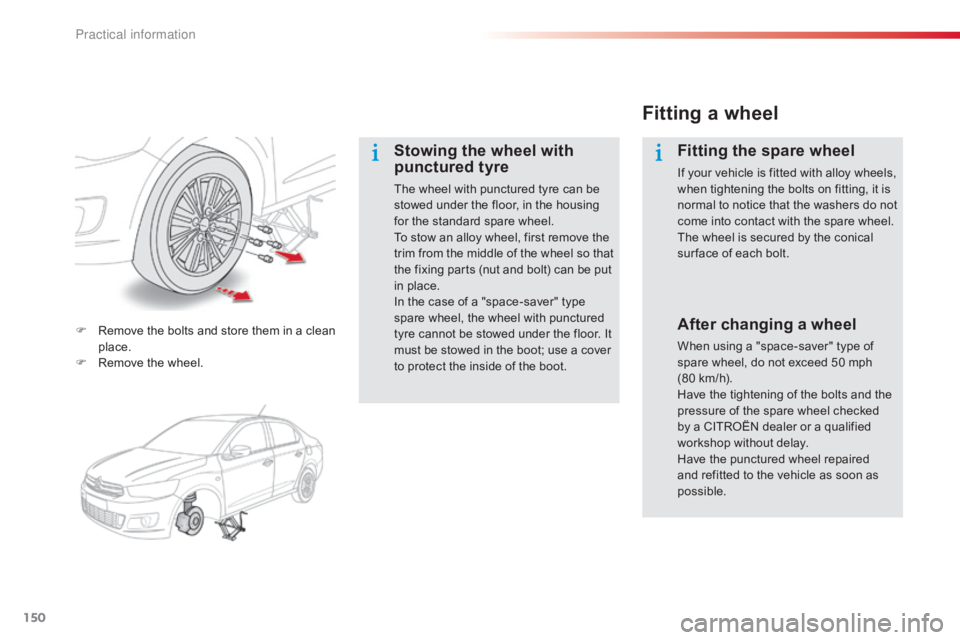
150
C-elysee_en_Chap09_info-pratiques_ed01-2016
F Remove the bolts and store them in a clean p
lace.
F
R
emove the wheel.
Fitting a wheel
Fitting the spare wheel
If your vehicle is fitted with alloy wheels, when tightening the bolts on fitting, it is
n
ormal
t
o
n
otice
t
hat
t
he
w
ashers
d
o
n
ot
c
ome into contact with the spare wheel.
T
he wheel is secured by the conical
s
ur face of each bolt.
After changing a wheel
When using a "space-saver" type of spare wheel, do not exceed 50 mph
(80
km/h).
Have
the tightening of the bolts and the
p
ressure of the spare wheel checked
b
y a CITROËN dealer or a qualified
w
orkshop without delay.
Have
the punctured wheel repaired
a
nd refitted to the vehicle as soon as
p
ossible.
Stowing the wheel with
punctured tyre
The wheel with punctured tyre can be stowed under the floor, in the housing
f
or the standard spare wheel.
To
stow an alloy wheel, first remove the
t
rim
f
rom
t
he
m
iddle
o
f
t
he
w
heel
s
o
t
hat
t
he fixing parts (nut and bolt) can be put
i
n place.
In
the case of a "space-saver" type
s
pare wheel, the wheel with punctured
t
yre cannot be stowed under the floor. It
m
ust be stowed in the boot; use a cover
t
o protect the inside of the boot.
Practical information
Page 153 of 260
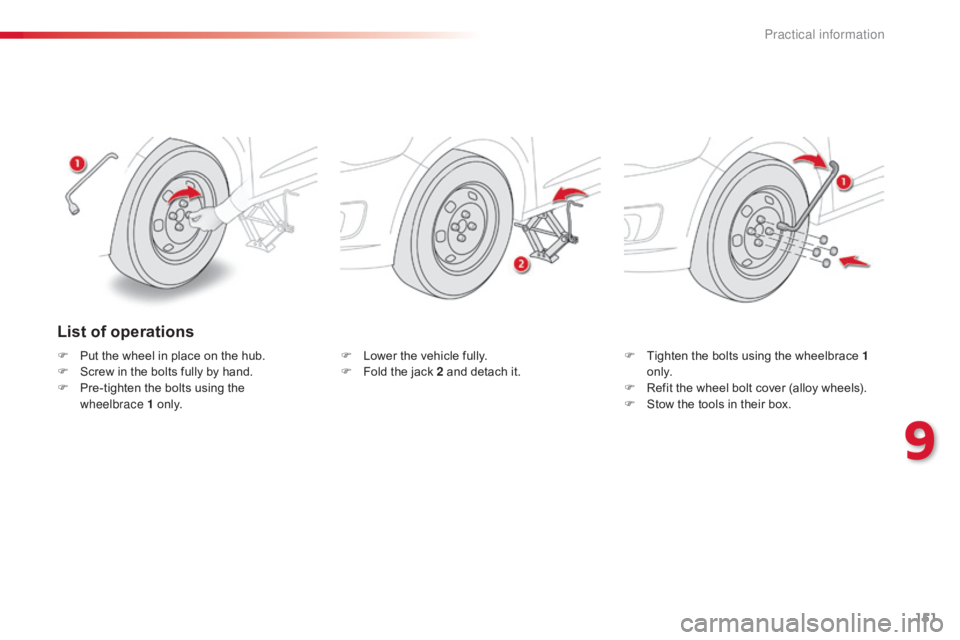
151
C-elysee_en_Chap09_info-pratiques_ed01-2016
F Lower the vehicle fully.
F F old the jack 2 and detach it.F
T ighten the bolts using the wheelbrace 1
o n l y.
F
R
efit the wheel bolt cover (alloy wheels).
F
S
tow the tools in their box.
List of operations
F Put the wheel in place on the hub.
F S crew in the bolts fully by hand.
F
P
re-tighten the bolts using the
w
heelbrace
1
o
n l y.
9
Practical information
Page 154 of 260
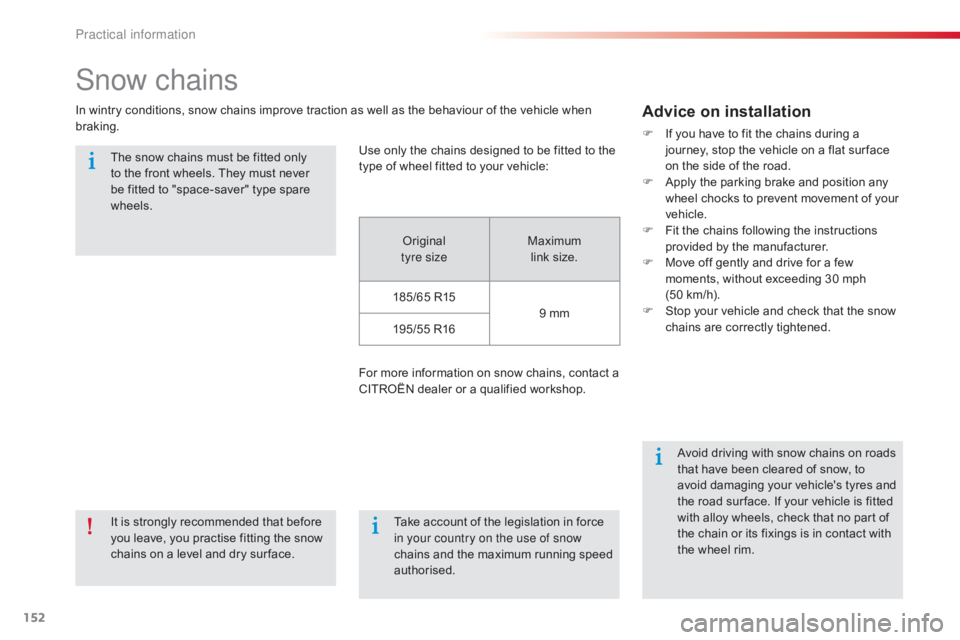
152
C-elysee_en_Chap09_info-pratiques_ed01-2016
Snow chains
In wintry conditions, snow chains improve traction as well as the behaviour of the vehicle when braking.Advice on installation
F If you have to fit the chains during a j
ourney, stop the vehicle on a flat sur face
o
n the side of the road.
F
A
pply the parking brake and position any
w
heel chocks to prevent movement of your
v
ehicle.
F
F
it the chains following the instructions
p
rovided by the manufacturer.
F
M
ove off gently and drive for a few
m
oments, without exceeding 30 mph
(
50 km/h).
F
S
top your vehicle and check that the snow
c
hains are correctly tightened.
Use
only
the
chains
designed
to
be
fitted
to
the
t
ype
of
wheel
fitted
to
your
vehicle:
Original
t
yre size Maximum
l
ink
size.
185/65
R15 9
mm
195/55
R16
For
more
information
on
snow
chains,
contact
a
C
ITROËN
dealer
or
a
qualified
workshop.
It
is
strongly
recommended
that
before
y
ou
leave,
you
practise
fitting
the
snow
c
hains
on
a
level
and
dry
sur face. Avoid
driving with snow chains on roads
t
hat have been cleared of snow, to
a
void damaging your vehicle's tyres and
t
he road sur face. If your vehicle is fitted
w
ith alloy wheels, check that no part of
t
he chain or its fixings is in contact with
t
he wheel rim.
Take
account
of
the
legislation
in
force
i
n your country on the use of snow
chains
and
the
maximum
running
speed
a
uthorised.
The
snow
chains
must
be
fitted
only
t
o
the
front
wheels.
They
must
never
b
e
fitted
to
"space-saver"
type
spare
w
heels.
Practical information